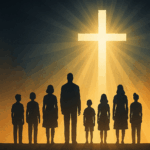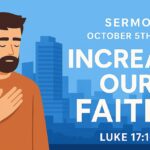“Above All Else : The Church” – 1 Corinthians 12:2-7, 17-27
1. The Definition of the Church
As we continue our series of sermons on the essentials of our Christian faith and how we live it out, we move on today to a consideration of the church. We will look at four things: the definition of the church; the nature of the church; the Biblical images of the church; the purpose of the church.
As we explore the definition of the church, we need to recognize that the word ‘church’ is used in different ways, portrayed in these sentences using the word:
In the Western world, the church is, by and large, responsible for the founding of hospitals. (‘Church’ means the indefinite world-wide organization.)
The Lutheran Church does mission work in many African countries. (‘Church’ means a church body, a denomination.)
The church is across from McLean Park. (‘Church’ means a building.)
Hope Church runs a K – 8 Christian school. (‘Church’ means a congregation.)
What time is church? (‘Church’ means the worship service.)
Interestingly, none of these uses of the word ‘church’ is truly Biblical. There were no denominations in the first century A.D., no church buildings that we know of, and although there were congregations they were not specifically named as a church. The word ‘church’ was definitely NOT used in the Bible to refer to worship. So, what is the definition of ‘church’ according to the Bible? For the answer to that question, we need to look at the Greek word that is most often translated as ‘church.’ That word is ‘ecclesia’ from which we get our English words ‘ecclesial’ and ‘ecclesiastical.’ ‘Ecclesia’ is a compound word formed from the word ‘ek’ meaning ‘out’ or ‘out of’ and the word ‘clesia’ which is a form of the verb ‘kaleo’ meaning ‘to call.’ Together they refer to people who are ‘called out’ much like the people of Israel were ‘called out’ to be a separate and holy people for the Lord. In the Christian context, we are ‘called out’ to belong to the Lord Jesus and to be different from the world… in the world but not of it. So, truly, the word can properly refer to individuals who, as Paul said in 1 Corinthians 12, truly and sincerely and personally confess “Jesus is Lord, Jesus is my Lord.” In other New Testament contexts those believers are the ‘saints,’ the ‘holy ones’ – but it can also refer to the gathering or assembly of those individuals for study and for worship.
2. The Nature of the Church
Next, we consider the nature of the church. What are its characteristics? When we confess the Nicene Creed, as we did today, we are pointing to the nature of the church as ‘one, holy, Christian and apostolic.’ Let’s use those adjectives from the Nicene Creed to help us understand the nature of the church, the large church.
First of all, it says the church is one. The church is one because there is one Christ. This is what we read in our Epistle reading: “For just as the body is one and has many members, and all the members of the body, though many, are one body, so it is with Christ. For in one Spirit we were all baptized into one body—Jews or Greeks, slaves or free—and all were made to drink of one Spirit.”
Paul expressed much the same thing, with an emphasis on unity, in Ephesians 4: “There is one body and one Spirit – just as you were called to the one hope that belongs to your call – one Lord, one faith, one baptism, one God and Father of all, who is over all and through all and in all.” The “one body” means the church, the assembly of those “called out ones.” That means that, despite the differences we may have between denominations in the world-wide church, there is more that unites us than divides us. Our one Lord Jesus makes us all one.
The next adjective from the Nicene Creed is “holy.” That is true because its members have the forgiveness of sins, thanks to the sacrifice of Jesus on the cross. When God looks at you, He sees you through the lens of the purity and holiness of Jesus. He no longer sees your sin, but He sees you as saints, forgiven saints, holy ones.
The third adjective that describes the church is Christian. [whisper…] OK, don’t tell anybody, but that’s kind of like saying the church is… catholic!! In both the Apostles’ and the Nicene Creeds, the word ‘Christian’ was ‘catholic’ in the original Latin, and it referred to the ONE world-wide or universal church, and not to a denomination as we generally understand it today. Somehow we Lutherans seem to be ‘allergic’ to the word ‘catholic,’ so we have replaced it with the word ‘Christian’ in the Creeds because that is more palatable. But again, whereas the word ‘Catholic’ with a capital ‘C’ means the Roman Catholic Church, small ‘c’ catholic is just that broad sense of the universal church – kind of like the first use of the word I offered before – “the church founded hospitals.”
The final descriptor in the Nicene Creed is the word “apostolic.” That means the church is built on and draws its very life from the writings of the apostles of Jesus. They are the ones who recorded the Gospels – the life, ministry, death and resurrection of Jesus – and they are the ones who, in their letters, pointed to what it means to live as followers of Jesus. When St. Paul describes the church in Ephesians 2, he writes that it is “built on the foundation of the apostles and the prophets, with Christ Jesus Himself as the chief cornerstone.” What the apostles wrote about is built on the person and work of Jesus as ground zero – the center and origin of what we believe. ‘Apostolic’ can also have the sense of “being sent,” but we’ll get to that when we get to the purpose of the church.
There is actually one more descriptive phrase in the Apostles’ Creed. There, after we say that we believe in the Holy Spirit and the Holy Christian church, we add the phrase “the communion of saints.” That is a reference to the assembly / the gathering of all those who follow Jesus – those of the past who are already with Jesus in heaven, those of the present no matter where in the world they live, and those who will follow Jesus in the future. That is to say that the church has no bounds of time or culture or geography. Every person who is called out to faith in Jesus is part of that community of the saints.
3. The Biblical Images of the Church
The third thing that will help to complete our view of the church is some Biblical images of the church.
The first image of the church is that of a Bride. The concept of marriage runs through the Bible from beginning to end. In the 2nd chapter of the Bible we hear about the marriage of Adam and Eve… “For this reason a man will leave his father and mother and be united to his wife, and they will become one flesh.” The Old Testament often described the people of Israel as the Bride of God, with the Book of Hosea featuring that as a lived-out-parable in the prophet’s life. The New Testament and even some parables of Jesus narrow that focus to portray the Church as the Bride of Christ and to portray the Kingdom of God in marriage and wedding terms. The church is a living group of forgiven human beings intimately joined to the bridegroom, Jesus Christ, in a relationship of love and respect and honesty and faithfulness. God’s love affair with humanity reached its climax on the cross of Calvary. That’s where Jesus said “It is finished!” That’s where Jesus bought and paid for you with His blood. That’s where Jesus ultimately took us as His bride. That imagery continues until the second last chapter of the Bible where the Holy and heavenly city of Jerusalem is prepared as a bride beautifully dressed for her husband. Remembering that the truly Biblical sense of the word ‘church’ is in reference to God’s people, you can consider yourself to be Christ’s bride.
A second image of the church is of the flock of God. This, too, is an image that runs through the entire Bible – with both Old Testament Israel and New Testament Church being portrayed as the sheep, and God and Jesus being the Shepherd. Isaiah acknowledges that we, like sheep, have gone astray from God, and Jesus, too, tells a parable about a lost sheep that the Good Shepherd diligently searches for until He finds it. Jesus commented that the crowds were like sheep without a shepherd. There are still people today that are lost from the shepherd’s care because they don’t know Jesus. What is first and foremost in the mind of God is that lost sheep be saved. This was the reason that He sent His Son, Jesus, to die on a cross… so that lost sheep would be saved. When they are, the sheep listen to His voice, and follow Him. The Shepherd knows His sheep and calls them by name and leads them to green pastures and still waters. Jesus is the Good Shepherd who laid down His life for the sheep, and who will bring them to the full and abundant pastures of heaven.
A third image of the church, especially in the New Testament is that of the household of God. There are lots of phrases in Paul’s letters especially that support and flesh out that household / family imagery. In Ephesians 2, Paul describes the distinction between the old reality of being foreigners to God’s promises, without hope, separate from God AND the new reality of being included as members of God’s household. In other places, Paul writes about being adopted into God’s family, about being sons and daughters, about being brothers and sisters of Jesus Christ and therefore brothers and sisters of one another. There are a couple of passages about being disciplined as God’s sons, but more about the blessings that we receive by virtue of being part of God’s family of faith. We have a Father who loves us deeply, and because of that we love one another, we have a sense of belonging, we share experiences, and we help one another in time of need – rejoicing with those rejoice, and suffering with those who suffer.
The fourth image of the church is that of a human Body. This is the one that was documented wonderfully in our Epistle reading from 1 Corinthians 12. Paul explained that just as in a human body all the parts, though varied in their appearance, work together for the common good, so in the church, all the members work together for the good of the whole church.
The birds once got together to start a church. Mrs. Canary wanted all the emphasis on singing. “Singing should be the center of our worship,” she said.
But Mr. Owl quickly spoke up and said, “No, wisdom is most important. We need to center our church upon wisdom.”
Then Mr. Duck stated his interest. He said, “I think, whatever we do, we should build our church by a lake.”
The trumpeter swan spoke up at once, “We need a great pipe organ – that is what is most important for our church… a pipe organ.”
And so it went, with each of the birds pushing for their own interests in the church. Needless to say, that church was for the birds!
It is God’s church, not ours to mold which ever way we want to mold it. Because the Holy Spirit gives gifts and service, Paul says that there is no room for either despair or pride. Don’t despair if you don’t have public and splashy gifts and roles in the church. Don’t have pride that your gifts and roles appear greater than others. All are gifted. All are needed. All contribute. All work toward the common purpose that we have been given by Christ – who, we could say, is both the head and the heart of the Body, the church. We receive our direction and our inspiration from Him.
4. The Purpose of the Church
Finally, we need to answer the question of the purpose of the church. The best answer to that question is a two-fold answer. The first answer is that the church is meant to grow up and to grow together. We are called to develop and deepen our faith in Jesus, and we are meant to encourage and bless one another in that growth.
Listen to how Paul describes it in Ephesians 4 (and he uses “Body of Christ” language):
“[God] gave some to be apostles, some to be prophets, some to be evangelists, and some to be pastors and teachers, to prepare God’s people for works of service, so that the Body of Christ may be built up until we all reach unity in the faith and in the knowledge of the Son of God and become mature, attaining to the whole measure of the fullness of Christ… Speaking the truth in love, we will in all things grow up into Him who is the Head, that is, Christ. From Him the whole body, joined and held together by every supporting ligament, grows and builds itself up in love, as each part does its work.”
The pastors and teachers part… we’re going to save that until next Sunday. But notice that God’s people are to become spiritually mature in the fullness of Christ – that’s growing up in our faith, with Bible study and a full and vibrant devotion/prayer life. And we are each to do our God-given work, works of service, so that the whole body can be held together as all the parts encourage and sustain one another. One might be in leadership. Another might give generously. A third might do acts of mercy. A fourth might teach. But they all work together for the health and strength of the body.
The second purpose of the church comes from the lips of Jesus Christ, Himself. The Great Commission of Jesus to His disciples, and to us, is found in all four Gospels and also in the Book of Acts. Probably the most famous version is in Matthew 28 (something the “Front to Back” Bible readers are going to read tomorrow): “Go and make disciples of all nations, baptizing them in the name of the Father and of the Son and of the Holy Spirit, and teaching them to obey everything I have commanded you. And surely I am with you always, to the very end of the age.” Just before the Ascension of Jesus, the Book of Acts records Jesus’ words: “When the Holy Spirit comes on you… you will be my witnesses… to the ends of the earth.” So that’s the second purpose of the church – to be the people of God in our world (remember the blue cord in these tassels – we represent the fact of God, the presence of God, the words of God to those in our circles of acquaintance)… so to be the people of God, and to proclaim the name of Jesus, and to call on those who don’t know Him to follow Him in life-long discipleship. After growing up in our own faith, and after growing together in the church, we are to grow out in all the world to the ends of the earth. We do that through corporate ministry activities like the 40 or so volunteers who joyfully served at the Bible Camp we held for children this past week. But we also call people to discipleship individually as we share in one-on-one spiritual conversations with friends, co-workers and family members, or as we pray with someone at a hospital bed.
The purpose of the church is to grow internally, and to grow externally…. Not one or the other, not one without the other, but both together. [Oh, and if you didn’t get a tassel a couple of weeks ago, I still have some left.]
**Bonus Material: Being the Church
OK… because you have been such attentive listeners today, I’m going to add just a minute or so of bonus material on “Being the Church.” This will be practical because you will need to continue to be the Church during the upcoming pastoral vacancy. So, in a month’s time, you can be the church in these real and relevant ways:
– care for one another – if someone is in the hospital… go visit; if someone loses a loved one… mourn with them; if someone is new here… welcome them; if someone needs a meal… don’t wait for someone else to provide it.
– meet together – continue your Bible Study groups, maybe start a new one; continue those prayer nights; above all continue to meet together regularly on Sundays for worship.
– encourage one another – when someone has had a discouraging event – job loss, family turmoil, health uncertainty – send that person a card, make a phone call, or just listen and pray.
– step up and take on roles of leadership and servanthood – it may not seem that way initially, but often those two things go together… leadership and servanthood; if you see something that needs doing, round up some people with you and get it done, because it was Paul – not Covid – that taught us… “we’re in this together, we are the Body of Christ.”
– finally, give people grace – when people don’t do as good a job at something as you expect or as you would have done, give them grace; they might need practice, or time, or mentoring; and forgive others when needed, knowing that you, too, have been forgiven first by God.
And that’s what it means to BE the Church. You ARE the Church! Jesus is the Bridegroom, the Shepherd, the Head. Be His face, His presence to your world. Amen.









